 |
| Palms Women's Club (detail, showing the unfortunate addition of faux-flagstone siding) |
(Note: In the text below there are a number of passages suggesting that one building or another is likely the oldest building in the neighborhood, or close to it. As of 2015-09-14 new information--to me, that is--has come to light regarding a couple of still older buildings. This post will be revised accordingly and republished in the near future, but for now this disclaimer will have to do.)
Today Palms is an area of Los Angeles which is typically defined by what it isn't. It's not Cheviot Hills or Culver City, and it's not Mar Vista. And although its Westside credentials are undisputed, it isn't properly part of West Los Angeles because it's on the wrong side of the 405. For historical reasons its boundaries have always been uncertain, and even today various sources like the L.A. Times and the Palms Neighborhood Council disagree on the exact boundaries--sometimes virtually on a house-by-house basis. Many local place names in Spanish have definite articles--La, El, Los, or Las and that might have inspired the mostly Anglo and Midwestern settlers who named this place The Palms. In English this sort of thing works when the name doesn't otherwise mean anything, like The Bronx or The Dalles. But with common nouns like palm, especially in Southern California, not so much. In researching the LAPL photo database for this blog post the first hits that came up were the palm tree designs that used to grace the walls of the Cocoanut Grove!
 |
| Northeast Palms, from the 1910 Sanborn map |
Researching the history of L.A. often takes superior dedication when it comes to districts that were once considered remote suburban villages. The maps from different years sometimes show multiple name changes for the same street, for example Cyprus Avenue in the 1910 map
 |
| 1928 street map from the David Rumsey Collection |
Before it was swamped by the spring tide of post WWI urban sprawl, Palms stood in the center of the agricultural district where it had been founded in the 1880s. The early 1900s found it a thriving community of about a thousand inhabitants, boasting the assortment of small businesses typical of farming villages in that era. There was also the Villa or Palms Villa Hotel; the archives of the Los Angeles Times indicate it had been operated by one M.J. Howard, beginning no later than 1890. Again like many small towns, there were no saloons, although some enterprising businesspeople did their best to quench local thirsts by operating just outside the town limits. The local elementary school had already been operating for some years and around this time moved to its present site on the southeast corner of Palms Boulevard and Motor Avenue. It's likely that the little community boasted a telephone exchange as well, but available sources are silent on this. In addition to all these amenities there was the Palms train station, served by both Southern Pacific and Pacific Electric trains--steam and electric traction respectively.
This was one of the very last Pacific Electric routes and passenger service was finally ended altogether in 1953. Ten years later, thanks to local preservation advocates, the old station was moved lock stock and barrel to Heritage Square, near Pasadena, where it lives on as a museum piece. Today the local Metropolitan Transit Authority has already brought passenger service back to the Expo route as far west as Culver City, and by 2015 it is supposed to be in service all the way to Santa Monica. The new Metro station is currently under construction and stands about 100 yards east of where its predecessor stood.
 |
| New Palms Station under construction at Palms and National |
The old railroad bridge partially visible behind the new eastbound bridge is said to be the only extant one from the old railroad which will be incorporated into the new transit line. In line with the MTA's rather drab standards when it comes to naming stations, plans originally called for this one to be called Palms/National. We can all be grateful for the Palms Neighborhood Council which persuaded the MTA to name it simply Palms. Why should we care? We care because L.A. doesn't tend to be a city of named districts, except for a few formerly independent cities like Hollywood and Palms. A good place name is more than just a label; it simultaneously reflects and reinforces the character of a location.
Palms was annexed by Los Angeles in 1915, but continued to maintain a distinct personality as a community within the city. The Palms Chamber of Commerce continued its activities, and the next few years saw the founding of two Masonic lodges and the Palms Women's Club, which had its clubhouse on Palms Boulevard. Incidentally, the name of this thoroughfare has been changed at least twice: A Sanborn map from 1910 shows it as Cypress Avenue, and on a 1928 street map of L.A. it's Stilson Avenue. In fact, the history of this area is rife with street name changes, sometimes complicating matters with regard to historical research.
The building's front was emblazoned with a large letter 'P' whose style and color have evolved through the years, and still recalls the building's original occupants although it has been vacant for many years. The PWC was active at least into the 1960s, according to available sources. Today it's vacant and it's for sale, and it will be interesting to see what happens. Developers are betting big on the future growth and demand for apartments in this area, but this particular slice of ground doesn't seem too well suited for that. Recently in an apparent effort to spruce the place up, the door was replaced and painted red. For some reason this brings out the private residence-like character of the place; it doesn't really seem like anything else.
Although currently vacant, the building has recently housed a hairdressing salon. The building next door houses the offices of a consulting structural engineer; one can't help wonder if the 1912 structure has also been used for some sort of engineering or design work. The expansive windows seem calculated to let in the most light possible for the detailed work those fields entail. On inside, the windows have been papered over making it impossible to see how the interior is divided. However, at least the front room is evidently a single-story space with a high ceiling.
Although one would never think so, public records indicate that the next oldest building is probably the Marcus Building at the southeast corner of Motor and National, and it was built in 1915. For many years it was occupied by Norm's Foams and Fabrics, but it is now occupied by a new enterprise doing business as I Love Lucite. Well, who doesn't, after all? My favorite childhood toy was a Lucite molding kit.
Palms was annexed by Los Angeles in 1915, but continued to maintain a distinct personality as a community within the city. The Palms Chamber of Commerce continued its activities, and the next few years saw the founding of two Masonic lodges and the Palms Women's Club, which had its clubhouse on Palms Boulevard. Incidentally, the name of this thoroughfare has been changed at least twice: A Sanborn map from 1910 shows it as Cypress Avenue, and on a 1928 street map of L.A. it's Stilson Avenue. In fact, the history of this area is rife with street name changes, sometimes complicating matters with regard to historical research.
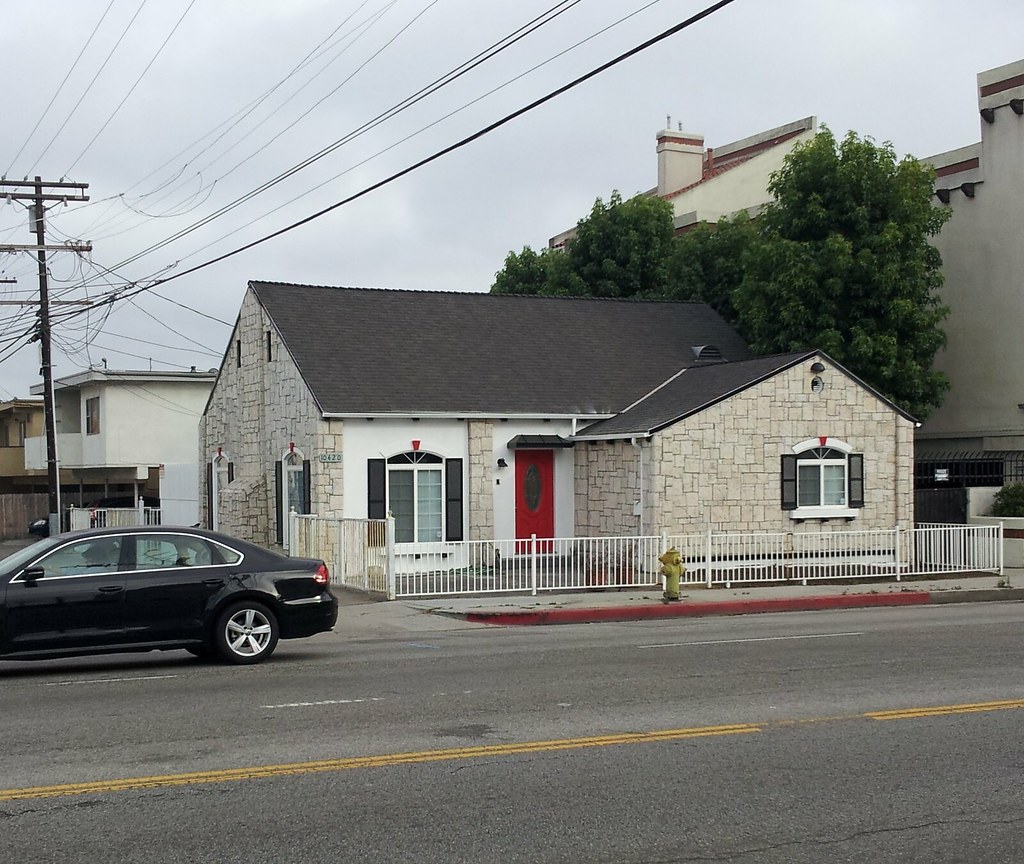 |
| Palms Women's Club |
Early Commercial Development
Just as it is today, in the beginning the commercial core of Palms was along Motor Avenue (then Fourth Street) particularly near the intersection with National Place. Other important thoroughfares included Overland Avenue and Palms Blvd, which was then called Stilson Avenue. According to public records, 1912 saw the construction of what must be the earliest extant commercial building in Palms. The structure displays a number of architectural features typical for the era, like the transom windows and the decorative exterior touches that seem to emanate from the building's basic fabric of bricks, rather than being merely plastered on. Traditional revivalist details, like classicist pilasters, plinths, or capitals, are entirely absent.
 |
| 1912 building on Motor Ave., likely the oldest extant business building in Palms |
 |
| 3343 Motor, main entrance |
 | ||
| Detail of transom windows. The louvered center window is probably a replacement. |
Although one would never think so, public records indicate that the next oldest building is probably the Marcus Building at the southeast corner of Motor and National, and it was built in 1915. For many years it was occupied by Norm's Foams and Fabrics, but it is now occupied by a new enterprise doing business as I Love Lucite. Well, who doesn't, after all? My favorite childhood toy was a Lucite molding kit.
No it wasn't.
Around the corner, just beyond the mailbox, there's a highly unusual feature: a small loading door just even with the sidewalk.
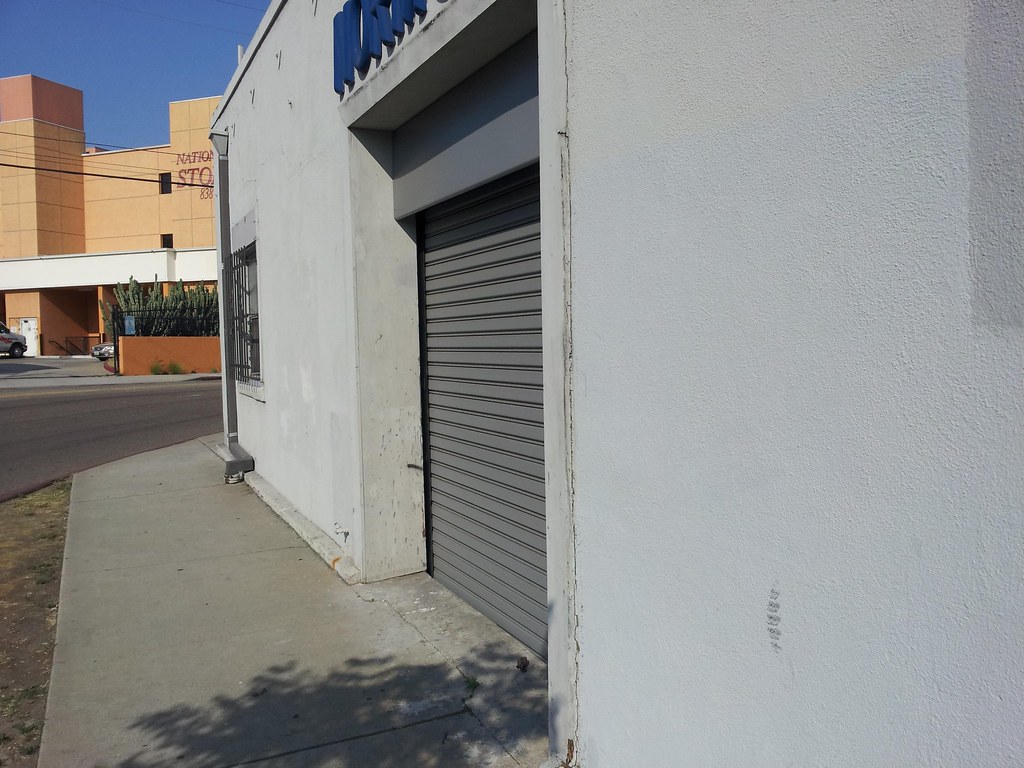 |
| Oddly placed loading dock |
Given the age of the building, and the fact that the Expo Line/Air Line rail route runs just behind the storage facility, it's plausible that there was once a freight spur here, a very long time ago. In many places along and near the rail line, there are old freight loading doors, now completely disused. In some cases these doors are a considerable distance away from the railroad, indicating that there were obviously freight spurs at one time, long since removed or asphalted over.
But why would the freight door be flush with the sidewalk? Even for trucks it wouldn't make much sense. We can only speculate at this point, but it's possible the ground was raised when the street was laid.
It's not easy to see in the picture, but there is definitely a rise in National Place, just past the intersection; as you keep going around the bend in the distance, the road quickly descends back to its original level. If anyone knows of a detailed spur map for this locale, please feel free to post a link to it in the comments.
UPDATE: In the course of an additional visit we took this photo which lays to rest any notion of this having ever been a freight dock. The track of the sliding aluminum door goes well below sidewalk level to what must have been the original street level.
Thanks to further inquiries with the extraordinary community of L.A. history buffs to be found in the enormous and ongoing Noirish Los Angeles thread in the Skyscraper Page Forum, we are now able to confirm this. In this particular instance I'm indebted especially to a member who provided me with several historic Sanborn maps of the corner in question. In 1910 the lot was partially occupied by a blacksmith's shop (BLSM) as well as what appears to represent a stationary gasoline engine. A century ago stationary gas engines were very commonly used in blacksmith shops, among other things to keep a powerful jet of air blowing into the forge to raise its temperature. (In earlier times this would have been done by one or more apprentices working hand bellows.)
In these early years of the automobile repair industry, it wasn't at all unusual for blacksmiths to become auto mechanics. Many of them were already familiar with stationary engines and this expertise carried over to auto engines; their metalworking expertise was a plus.
As the 1924 map shows, this became an example of that:
UPDATE: In the course of an additional visit we took this photo which lays to rest any notion of this having ever been a freight dock. The track of the sliding aluminum door goes well below sidewalk level to what must have been the original street level.
Thanks to further inquiries with the extraordinary community of L.A. history buffs to be found in the enormous and ongoing Noirish Los Angeles thread in the Skyscraper Page Forum, we are now able to confirm this. In this particular instance I'm indebted especially to a member who provided me with several historic Sanborn maps of the corner in question. In 1910 the lot was partially occupied by a blacksmith's shop (BLSM) as well as what appears to represent a stationary gasoline engine. A century ago stationary gas engines were very commonly used in blacksmith shops, among other things to keep a powerful jet of air blowing into the forge to raise its temperature. (In earlier times this would have been done by one or more apprentices working hand bellows.)
 |
| SE Corner Motor Avenue and National Boulevard, 1910. Motor runs along left edge, unmarked. |
In these early years of the automobile repair industry, it wasn't at all unusual for blacksmiths to become auto mechanics. Many of them were already familiar with stationary engines and this expertise carried over to auto engines; their metalworking expertise was a plus.
As the 1924 map shows, this became an example of that:
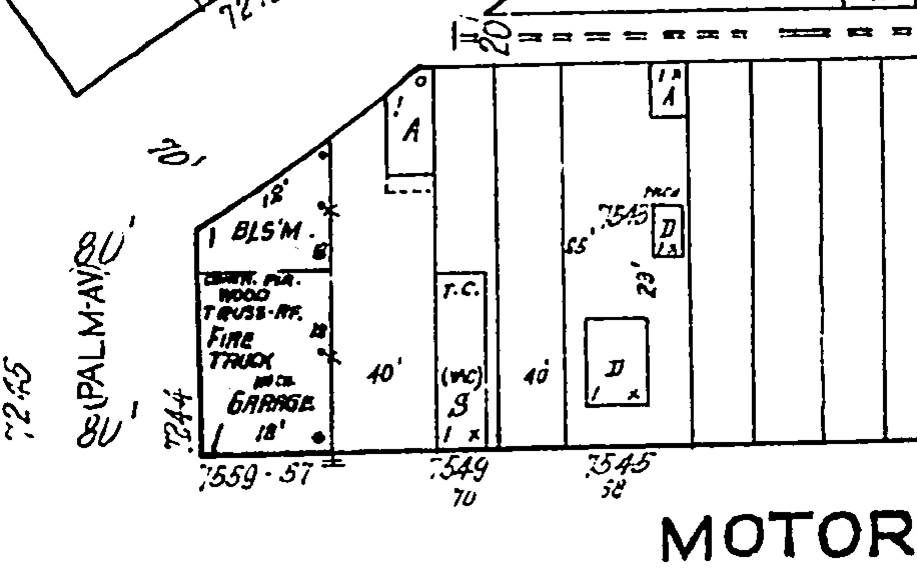 |
| SE Corner Motor/National, 1924 East is up (not according to astronomy, but the street numbering scheme) |
1924 finds our building used as a garage for fire engines, and the blacksmith is still there as well. The fire equipment, by this time, would have belonged to the LAFD, which had established Company 43 in the neighborhood the previous year in a nearby building a few doors west.
That same year, Hal Roach Studios used the blacksmith shop as a filming location for the 1924 Little Rascals film Sun Down Limited; here the Rascals are driving their makeshift train into the the rear door of the building, where the blacksmith shop is shown on the map above. This information comes to us through an extraordinary series of filming-location documentaries published on YouTube by one chrisbungostudios.
It turns out that numerous early Hal Roach films were shot in and around Palms.
By 1929 this space is being used for general auto repair, and the ceilings have been lowered from 18 to 12 feet.
Although the seemingly odd placement of the aluminum roll-up door has been explained, the facts concerning when the road was raised and why remain to be discovered.
That same year, Hal Roach Studios used the blacksmith shop as a filming location for the 1924 Little Rascals film Sun Down Limited; here the Rascals are driving their makeshift train into the the rear door of the building, where the blacksmith shop is shown on the map above. This information comes to us through an extraordinary series of filming-location documentaries published on YouTube by one chrisbungostudios.
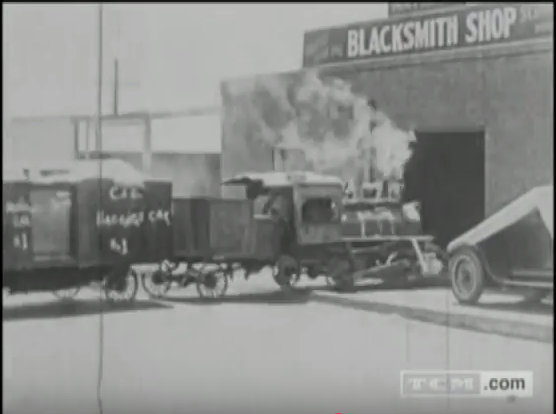 |
| Credited to chrisbungostudios. |
By 1929 this space is being used for general auto repair, and the ceilings have been lowered from 18 to 12 feet.
 |
| SE Corner Motor/National, 1929. |
Across the street from the former fire engine/auto repair facility stands Palms' most distinctive building, 3301 Motor Avenue.
Los Angeles had annexed Palms some eight years before this building was completed, but that didn't stop the owners and architect from following a pattern that was very typical of a small-town main street--small shops downstairs and small apartments upstairs. People definitely live here, and the corner unit was recently offered for rent, but we've never seen anyone go up or come down these steps.
 |
| The mysterious steps. |
It's a pretty good area. Vegan, Indonesian, and Mexican restaurants, and a barbershop where they use straight razors all jockeying for space in this short block...
...men's hats and a Karate studio that seems to specialize in children's classes, judging from the high pitched shouts to be heard heard from the sidewalk you walk past...
what more could we ask? Plenty--to wit, a place to drink coffee and a place to drink actual drinks. We're covered on the second requirement; there are three pubs within a few blocks of here, including the popular Irish Times just a few steps north of here on Motor. But there aren't any coffeehouses; even a Starbucks or one of the other chains would be better than nothing.
...men's hats and a Karate studio that seems to specialize in children's classes, judging from the high pitched shouts to be heard heard from the sidewalk you walk past...
what more could we ask? Plenty--to wit, a place to drink coffee and a place to drink actual drinks. We're covered on the second requirement; there are three pubs within a few blocks of here, including the popular Irish Times just a few steps north of here on Motor. But there aren't any coffeehouses; even a Starbucks or one of the other chains would be better than nothing.
A note about cartographic sources
The Sanborn maps were published for about a century beginning in the mid-1800s, intended for use by insurance underwriters in assessing fire risks. Hazards such as lumberyards, stationary gas engines, milling operations, absence of night security, and so on were shown. Mitigating factors such as nearby firehouses and hydrants were likewise shown, along with details as to the local fire service--paid or volunteer, full time or part time, number of men, and so on. (Of course it was men only--this was a long time ago.) For Palms the Sanborn collection lists only one set published in 1910, presumably because it would soon be annexed by Los Angeles. However, subsequent Sanborn editions group this area with Culver City rather than L.A. For both 1924 and 1929, it can be found on page 22 of the Culver City maps.
Much of Los Angeles and environs is covered in the Baist series of real estate survey maps, published for this area in 1921. Locating the correct plate for such a geographically large city as L.A. can be very difficult, what with changes in street names and realignments, and in some cases the total removal of streets. There are no references to the Baist maps in this blog post, but as an aid those readers who may wish to pursue this further, the map for Palms is found on Plate 38 (recto); this page can be found in the David Rumsey online historical map collection, here.



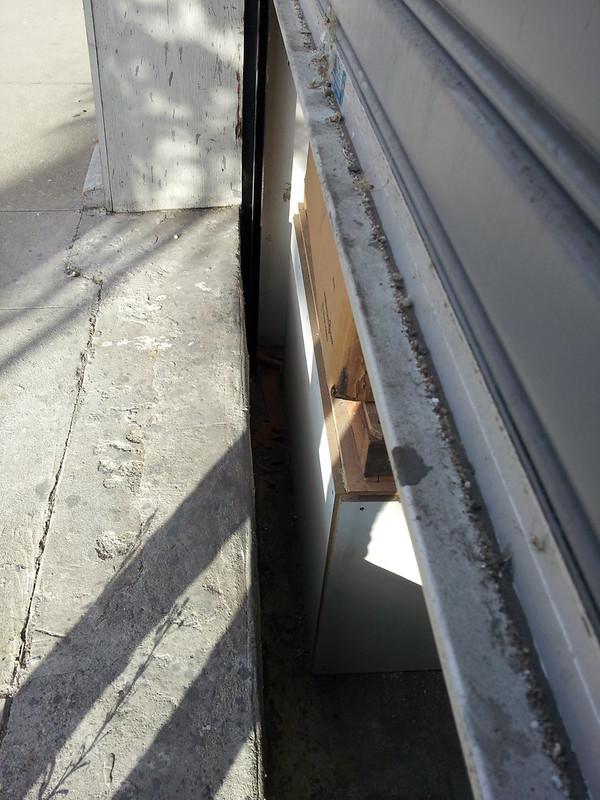

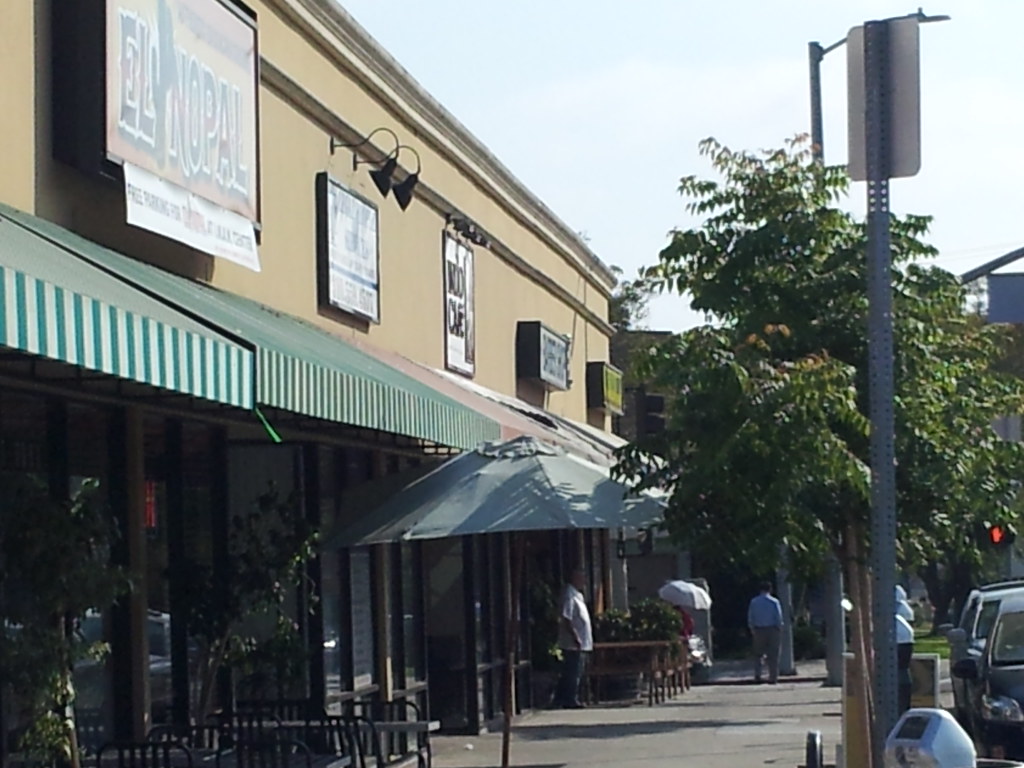

great blog! thank you. love historical tid bits. I've lived in Palms for 3 years. Looking forward to the renaissance brought on by the recent developments in construction & Metro Rail. Bring it on! ;)
ReplyDeleteInteresting article, but I wish you had seen fit to credit my book for some of the information you posted.
ReplyDeleteThis comment has been removed by the author.
DeleteI have recently reached out to Mr. Guarrigues and we will address his concerns in the near future.
DeleteI apologize to the author of this blog. The similarities of content in our two works are obviously due to both of us having done our research in the same or similar resources. Both of us used a bit of the same information because our great minds ran in the same track — the Pacific Electric Air Line track maybe? My thanks to Mr. van Scoyoc for his plethora of new and previously unpublished information.
ReplyDeleteI do appreciate the clarification very much. It is certainly an undeniable fact that all of us researching the history of the region often refer to the same sources, especially as more and more of these have become available online in recent years.
DeleteRegardless, this does not excuse me from the proper acknowledgment of these sources, or of the other bloggers and writers who've gone before me, and to whom I owe a debt of inspiration--in the case of George, not only with regard to his book but also his extensive website on Los Angeles in the 1900s. To remedy this, in the near future I will post a list of acknowledgements on a page of its own in this blog. This will most likely happen as part of a general redesign effort by which I hope to make it more like a typical website and less like a blog
And now I have finally published an acknowledgments page, for anyone interested.
ReplyDeleteYesss.
ReplyDeleteIt was flowing to your site.
The second image "Motor Ave / National Blvd, 1910. Sanborn Fire Insurance Atlas, Los Angeles Public Library" can not be read in poor resolution of.
If you like, you do not sent me with good resolution?
I want you to know prior to the location of "Normsfoam & Fabrics" is written what. (Top right of the location)
In fact here, Motor Ave is that so were often used in location of the TV show "Our gang".
This corner has been used in the silent film "The Sun Down Limited (1924)".
Where is the top right corner of the place there was a mini railway.
In some scenes, that of "Normsfoam & Fabrics" や time "It's GameTime!" Has been taken.
Reference
Our Gang - Sundown Ltd. (1924)
www.youtube.com/watch?v=05zjuLlF1Go
The Sun Down Limited (1924) Filming Locations
www.youtube.com/watch?v=GzCcrC_P5dk
Building locomotive enters been derailed I think different.
It would be next to the same building.
I'm sorry in poor English.
xg854725@yf7.so-net.ne.jp
Thanks so much for writing, and especially for the Youtube links. I will definitely be updating this post to incorporate some of this new information. I will also incorporate stills from the Our Gang movie provided there are no copyright restrictions that would prevent this. This will all take some time because it has been such a long time since I published a new entry. Most probably, I will not publish the revision on this post until I also have a completely new post to publish with it.
DeleteI have, however, just replaced that second image with a much better one. If it still looks blurry, click on it, and then right-click on the resulting image. Click on "View Image", and then you should be able to see it as large and clearly as you want. That's for Mozilla Firefox; I presume it's much the same for other browsers.
At the Culver Hotel you can drink in the lobby bar while watching Laurel & Hardy silent movies projected on a wall. Frequently in the background of these old films you'll see--what else?--the Culver Hotel.